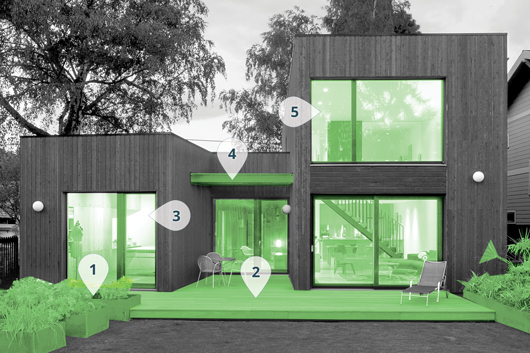
According to a 2012 National Association of Realtors survey, more than 70% of homebuyers are willing to pay more for a house with energy efficient features. Although demand exists, many green and high- performance features of a home are invisible to the naked eye and are left undocumented and under communicated to homebuyers. Real estate professionals are the best resource for communicating the proper value and benefits of a green home to homebuyers. Consider these tips to help you communicate and document the value of green and high-performance homes:
1.
Avoid greenwashing. Green claims need to be specific and meaningful, unpretentious and verifiable. In their annual Green Gauge Tracking Survey, GfK (a market research group) reported that 40% of the public does not think green claims are accurate. If you are going to make a claim, be humble, honest and do not over-promise. One of the best ways to ensure that a green claim is reliable is to consult with authoritative sources. Green building certifications are one way to ensure green claims have been verified along with product labeling such as ENERGY STAR ratings. The more environmentally savvy your client, the more wary he or she will be of greenwashing.
2.
Get to know the RMLS green fields. Our regional MLS was one of the first in the country to introduce green fields. Their early innovation has provided a level of sales data/information unrivalled in the nation. With green fields, brokers can identify the best property types for potential buyers that are interested in a home that is resource efficient or has superior indoor air quality. For example, brokers that are able to differentiate between the ENERGY STAR home certification (ENSTAR) and ENERGY STAR (ESTARAP) appliance abbreviations in a RMLS listing are more equipped to meet the needs of their clients.
3.
Use a green appraisal addendum. Earth Advantage and the Appraisal Institute have developed appraisal addenda that provide standardized information on green certifications, ratings and home attributes that allow for comprehensive valuation. These addenda can be presented to an appraiser during the home purchasing transaction for consideration in developing an option of value.
4.
Gain firsthand knowledge. Make an effort to experience firsthand those things that will help you speak with conviction and dispel long held myths about green homes. Seek out advanced training that teaches you the way high-performance and green homes are designed and built. Talk to homeowners and builders who live and build green homes to discuss the features that translate to benefits like greater comfort, lower energy bills, and healthier indoor air quality. The greater your expertise the more at ease and confident your clients feel about the benefits of green and high performance homes.
Eager to learn more? Join us September 9
th, 2014 for the
Value It Green Home Tour. This is the first tour in the country designed for real estate professionals to explore the best practices and tools available to successfully communicate the value of green and high performance homes. Visit homes and ADUs, learn about green valuation methods and best practices, and network with industry experts over cocktails. Visit
ValueItGreen.com to learn more!
 According to a 2012 National Association of Realtors survey, more than 70% of homebuyers are willing to pay more for a house with energy efficient features. Although demand exists, many green and high- performance features of a home are invisible to the naked eye and are left undocumented and under communicated to homebuyers. Real estate professionals are the best resource for communicating the proper value and benefits of a green home to homebuyers. Consider these tips to help you communicate and document the value of green and high-performance homes:
According to a 2012 National Association of Realtors survey, more than 70% of homebuyers are willing to pay more for a house with energy efficient features. Although demand exists, many green and high- performance features of a home are invisible to the naked eye and are left undocumented and under communicated to homebuyers. Real estate professionals are the best resource for communicating the proper value and benefits of a green home to homebuyers. Consider these tips to help you communicate and document the value of green and high-performance homes: